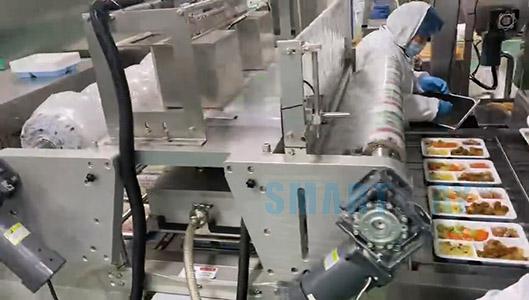Tray Sealing Machines Market Analysis Shows Rapid Growth in Meat and Seafood Packaging Segments

Introduction
The Tray Sealing Machines Market is witnessing a surge in demand from meat and seafood packaging applications, as these segments require the highest standards in hygiene, shelf life, and product presentation. Tray sealing technologies, particularly those incorporating Modified Atmosphere Packaging (MAP) and vacuum sealing, are meeting these needs effectively. With growing global consumption of animal protein and the push for safer, sustainable packaging, tray sealing machines have become essential assets for processors, distributors, and retailers alike.
Unique Requirements of Meat and Seafood Packaging
Packaging meat and seafood comes with inherent challenges: high perishability, temperature sensitivity, and the need for tamper-proof delivery. Tray sealing machines fulfill these requirements through:
-
Hermetic Seals: Prevent microbial contamination and fluid leakage.
-
Gas Flushing Systems (MAP): Delay spoilage by reducing oxygen levels inside the tray.
-
Temperature-Resistant Films: Maintain integrity under chilled or frozen storage.
-
Anti-Fog Lids: Ensure visibility of the product for retail display.
These features help maintain the quality and safety of perishable goods from processing facilities to consumer kitchens.
Growth Drivers in the Segment
Several trends are contributing to the rapid adoption of tray sealing in meat and seafood:
-
Rising Protein Consumption: With increasing demand for fresh meat, poultry, and seafood globally, especially in urban centers.
-
Export and Import Needs: Cross-border shipping of chilled products requires packaging solutions with extended shelf life and regulatory compliance.
-
Supermarket Expansion: As modern retail formats grow in developing regions, hygienically sealed meat trays become essential for mass merchandising.
-
E-commerce for Perishables: Online delivery of fresh protein is growing, necessitating robust, leak-proof packaging to maintain quality during transit.
These drivers collectively create sustained demand for efficient and reliable sealing technologies.
Applications in Meat Processing Plants
Meat processors rely heavily on automation to maintain consistency and throughput. Tray sealing machines are seamlessly integrated into conveyor systems where precise sealing is required for cuts of chicken, beef, lamb, or pork.
Features like automatic tray denesting, in-line gas flushing, and high-speed heat sealing enhance productivity. Machines also support various tray depths and cuts, from minced meat to steak portions, enabling operational flexibility.
In high-volume plants, double-chamber and multi-lane machines help scale output without compromising seal quality or hygiene.
Seafood Industry Adoption
Seafood packaging is particularly sensitive due to moisture content and rapid spoilage. Tray sealing systems have been adapted with specialized features such as moisture-resistant films, MAP tailored for aquatic products, and anti-drip sealing designs.
Frozen and chilled seafood products—like salmon fillets, prawns, and shellfish—benefit from vacuum skin packaging integrated into tray sealers. This not only extends shelf life but also enhances presentation by preventing movement and oxidation within the tray.
Role in Cold Chain Logistics
The cold chain is vital for meat and seafood. Tray sealing technology helps maintain product integrity throughout storage and distribution by minimizing temperature fluctuations and preventing exposure to contaminants.
Machines designed for integration with cold-room operations and automated weighing-labeling units are in high demand. These systems ensure sealed trays meet both safety regulations and branding requirements before they reach consumers.
Regional Expansion and Market Leaders
Countries with large seafood exports—like Norway, Chile, and Vietnam—are significantly investing in advanced sealing machines. In parallel, regions with growing urbanization and protein consumption, such as China and India, are adopting mid-range tray sealing systems for their local retail and wholesale markets.
Leading manufacturers are offering customizable solutions tailored to each market's infrastructure, regulatory needs, and typical packaging formats.
Challenges and Innovations
Challenges include equipment maintenance in wet or saline environments (particularly in seafood plants), the need for skilled operators, and fluctuating prices of compatible sealing films.
However, machine makers are innovating with stainless steel builds, corrosion-resistant components, and intuitive touch-screen controls to simplify operations. Some systems even offer automatic cleaning cycles to maintain hygiene with minimal downtime.
Conclusion: Protein Packaging Pushes Tray Sealing to the Forefront
With safety, presentation, and efficiency at its core, tray sealing technology is becoming indispensable in meat and seafood packaging. As consumers and regulators demand better protection and longer shelf lives for perishables, these machines provide the solution. In the next article, we’ll shift our focus to a broader perspective, analyzing how advancements in technology and global logistics are shaping the Tray Sealing Machines Market Overview.
- Art
- Causes
- Crafts
- Dance
- Drinks
- Film
- Fitness
- Food
- Games
- Gardening
- Health
- Home
- Literature
- Music
- Networking
- Other
- Party
- Religion
- Shopping
- Sports
- Theater
- Wellness


